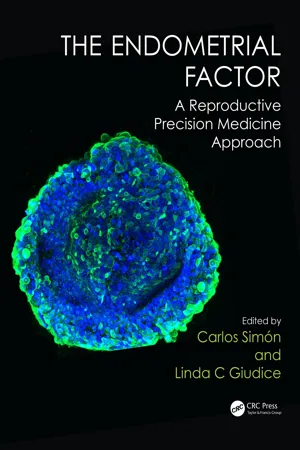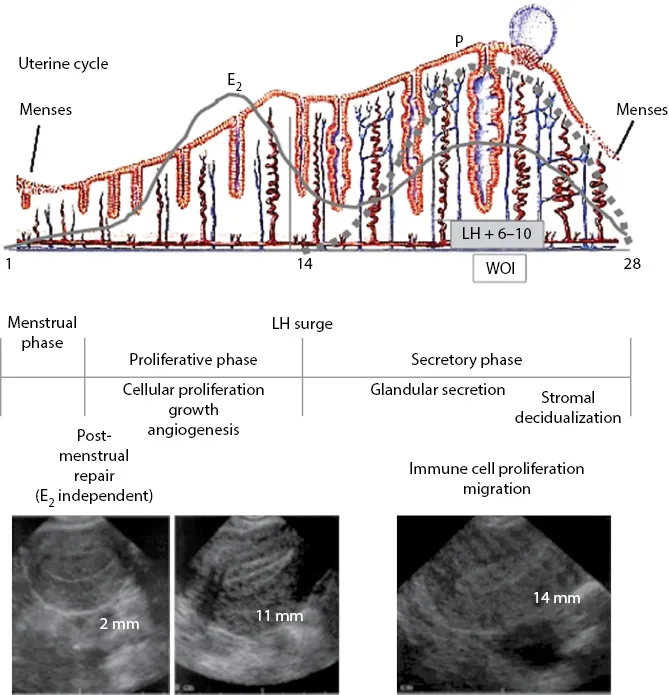
eBook - ePub
The Endometrial Factor
A Reproductive Precision Medicine Approach
- 272 pages
- English
- ePUB (mobile friendly)
- Available on iOS & Android
eBook - ePub
The Endometrial Factor
A Reproductive Precision Medicine Approach
About this book
At the dawn of precision medicine, there is a new opportunity for novel approaches to understand, diagnose and treat endometrial disorders that affect fertility, reproductive outcomes, and women's health more broadly. Herein, the editors have assembled critically evaluated state-of-the-art chapters presenting basic and clinical knowledge about the human endometrium that impacts or will impact clinical practice. All clinicians and researchers in Reproductive Medicine will find this book useful as a reference and a valuable tool for continued advancement in the understanding and management of the "endometrial factor".
Frequently asked questions
Yes, you can cancel anytime from the Subscription tab in your account settings on the Perlego website. Your subscription will stay active until the end of your current billing period. Learn how to cancel your subscription.
No, books cannot be downloaded as external files, such as PDFs, for use outside of Perlego. However, you can download books within the Perlego app for offline reading on mobile or tablet. Learn more here.
Perlego offers two plans: Essential and Complete
- Essential is ideal for learners and professionals who enjoy exploring a wide range of subjects. Access the Essential Library with 800,000+ trusted titles and best-sellers across business, personal growth, and the humanities. Includes unlimited reading time and Standard Read Aloud voice.
- Complete: Perfect for advanced learners and researchers needing full, unrestricted access. Unlock 1.4M+ books across hundreds of subjects, including academic and specialized titles. The Complete Plan also includes advanced features like Premium Read Aloud and Research Assistant.
We are an online textbook subscription service, where you can get access to an entire online library for less than the price of a single book per month. With over 1 million books across 1000+ topics, we’ve got you covered! Learn more here.
Look out for the read-aloud symbol on your next book to see if you can listen to it. The read-aloud tool reads text aloud for you, highlighting the text as it is being read. You can pause it, speed it up and slow it down. Learn more here.
Yes! You can use the Perlego app on both iOS or Android devices to read anytime, anywhere — even offline. Perfect for commutes or when you’re on the go.
Please note we cannot support devices running on iOS 13 and Android 7 or earlier. Learn more about using the app.
Please note we cannot support devices running on iOS 13 and Android 7 or earlier. Learn more about using the app.
Yes, you can access The Endometrial Factor by Carlos Simón, Linda C. Giudice, Carlos Simón,Linda C. Giudice in PDF and/or ePUB format, as well as other popular books in Medicine & Family Medicine & General Practice. We have over one million books available in our catalogue for you to explore.
Information
1
Highlights on the dynamism and multifunctionality of human endometrium in the era of precision medicine
Linda C. Giudice
Introduction
Precision medicine is an emerging field for disease prevention, classification, diagnosis, and targeted (individualized) treatment based on individual characteristics, including genetic variations, environmental exposures, lifestyle, and experiences across the life span (1). It derives from big science (“omics”), bioinformatics, and deep phenotyping. Big science includes the genome, epigenome, transcriptome, metabolome, microbiome, exposome, receptome, and other “omes” in which global profiling captures huge numbers of data points (e.g., whole genome sequencing). Bioinformatics is the interdisciplinary field that combines statistics, mathematics, engineering, and computer science to interpret biological data. Deep phenotyping involves extensive patient characteristics (e.g., age, body mass index (BMI), smoking, environmental exposures, zip code, socioeconomic status, pregnancy history, comorbidities, severities, symptoms, family history, and lifestyle) that get incorporated via bioinformatics to interpret findings of the big data. The end result is to diagnose and understand diseases at the individual level so that therapies are based on cross-referencing an individual’s personal history and biology with patterns found across large populations, utilizing the knowledge network to deliver care that is preventive, targeted, effective, and timely. The field is ideal for women’s health, where causes for most disorders are not well understood and there is great variability woman to woman in responses to treatments and also in outcomes. This is particularly true for the female reproductive tract and especially the endometrium, where there are unpredictable responses to the steroid hormone milieu and other factors that result in poor reproductive and other health outcomes. A long-term goal is to abandon empiric and “one-size-fits-all” therapies and adopt precision in fertility treatments, contraceptive and hormonal therapies, treating disorders of the female reproductive tract, and optimizing pregnancy outcomes. This chapter highlights the human endometrium in this context in the dawn of the age of precision medicine.
Human endometrium (modern Latin, from endo [“within”] + Greek mētra [“womb/uterus”]) (2), the anatomic prerequisite for continuing the species and a sentinel for protecting the upper female reproductive tract against mucosal infection, is a dynamic tissue responding cyclically to changing circulating ovarian-derived estradiol (E2) and progesterone (P4) (Figure 1.1). It undergoes cyclic cellular proliferation, differentiation, lymphangiogenesis, immune cell trafficking, and, in the absence of pregnancy, tissue desquamation and hemostasis, followed by regeneration (3). The goals of orchestrated events in endometrium are to permit successful nidation, growth, and survival of the semiallogeneic conceptus for 9 months, followed by involution and subsequent regeneration postpartum (4). Also, it has a major responsibility as a mucosal surface to protect the organism from infections by a variety of microbes (5). Abnormalities in one or more mechanisms underlying endometrial functionality during development, during a women’s reproductive years, during pregnancy, and postmenopause have profound consequences for fertility, pregnancy outcome, and women’s health more broadly. Hardly an “innocent bystander,” the tissue is affected, directly or indirectly, by systemic homeostasis, disease, stress, environment, nutrition, genetics, and hormonal status (age, endogenous, and exogenously administered). Herein, highlights of this remarkable tissue’s origin, physiology, metabolism, evolution, ecology, and plasticity are provided, with an eye to precision medicine, and serving as a backdrop to chapters that follow wherein some topics are presented in more detail. Also, it is hoped that the reader will be inspired to consider the complexities of the human endometrium in clinical practice and women’s well-being and in research in an effort to advance women’s reproductive health beyond empirical therapies, unpredictable endometrial responses, and unpredictable prognoses for contraception, fertility, pregnancy outcomes, and endometrial morbidities.

Figure 1.1 Circulating hormonal profiles of estradiol (E2) and progesterone (P4) and the endometrial response across the menstrual cycle phases and substages. Endometrial growth and patterns in early and late proliferative and midsecretory phases on transvaginal ultrasound are shown in panels A–C. (From Giudice LC. Reprod Biol Endocrinol 2006;4(Suppl 1):S4. With permission.)
Embryology and vulnerability to endocrine-disrupting chemicals
The uterus derives from the paramesonephric ducts first described by Muller in 1830 (6). The mesodermally derived paramesonephric (Mullerian) ducts differentiate into the luminal and glandular epithelial cell types of the endometrium, oviduct, cervix, and upper vagina, and the surrounding urogenital ridge mesenchyme differentiates into the endometrial stroma and inner and outer myometrial layers (7). Interactions between the mesenchyme and epithelium are essential for female reproductive tract formation and differentiation, and members of the Wnt and Hox gene families are important in these processes. In addition, mesenchymal and epithelial interactions and estrogen receptor (ER) signaling play important roles in adenogenesis and smooth muscle differentiation (7,8).
The developing female reproductive tract is highly vulnerable to estrogens and estrogen mimetics (9), and the human experience with diethylstilbesterol (DES) and several experimental studies in animals demonstrate long-term adverse reproductive effects in adults with in utero exposure to this endocrine-disrupting chemical (EDC). In humans, in utero DES exposure causes abnormal vaginal adenosis and uterine structural abnormalities in DES daughters (10). Similar results have been found in mice with in utero exposure to bisphenol A (BPA), another EDC structurally similar to DES and also signaling through the ERα pathway (11). In utero DES exposure results in changes in expression of WNT 7a, HOXA 10, and HOXA11 and altered uterine morphogenesis in female offspring (12,13), as well as causing epigenetic alterations in the uterus (hypermethylation of the HOXA 10 promoter and overexpression of DNA methyl transferases in the mouse (14)). Altered DNA methylation of HOXA 10 and ERα promoters is a recently recognized mechanism of BPA-induced altered reproductive tract developmental programming (15). It has been proposed that some abnormalities in ER-mediated events during female reproductive tract development may have their origins in various environmental (e.g., endocrine disrupters) or genetic factors, resulting in altered critical gene expression in stem or progenitor cells, giving rise to persistent abnormalities in the endometrium of adult women (16). Some examples include hypermethylation of HOXA 10 and hypomethylation of steroidogenic factor (SF) 1 and ERβ promoters, and progesterone receptor (PR) genetic variants in endometriosis (16). Thus, the endometrium and other components of the female reproductive tract are highly vulnerable to EDC exposure in utero, with potentially long-lasting effects on reproductive potential in adulthood that should be considered in preventive health strategies and optimizing reproductive health in the long term.
Hormonal control
Endometrium comprises several cell types, including glandular epithelium, luminal epithelium, stromal fibroblasts, vascular smooth muscle, and endothelium; an array of immune cells; and stem or progenitor cells (4). The glandular and stromal compartments undergo profound changes in response to circulating E2 and P4 across the cycle (Figure 1.1). A brief description of these changes is included here to underscore the events and to highlight how abnormalities c...
Table of contents
- Cover
- Title Page
- Copyright Page
- Contents
- Preface
- Foreword: An eye to the future
- Contributors
- 1. Highlights on the dynamism and multifunctionality of human endometrium in the era of precision medicine
- Section I: Diagnosis of the Endometrial Factor
- Section II: Personalization of the Endometrial Factor
- Section III: Therapeutic Options of the Endometrial Factor
- Section IV: The Ultimate Goal
- Index